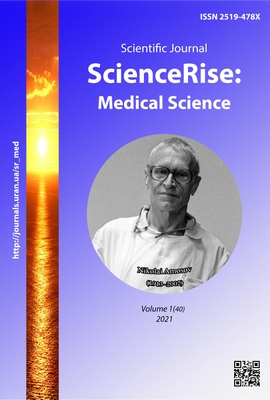Особливості стану периферичної оксигенації тканин при різних видах комбінованої анестезії у дітей з природженою хірургічною патологією
DOI:
https://doi.org/10.15587/2519-4798.2021.224662Ключові слова:
новонароджені, немовлята, природжені вади розвитку, комбінована анестезія, пульсоксиметріяАнотація
В представленій роботі проведена оцінка особливостей периферичної оксиметрії у дітей з природженими вадами розвитку хірургічного профілю при різних видах комбінованої анестезії.
Мета дослідження. Оцінити стан периферичної оксигенації у новонароджених і немовлят з природженими вадами розвитку при різних видах анестезіологічного супроводу.
Матеріали та методи дослідження. У ретроспективне дослідження були включені 150 новонароджених і немовлят з природженими вадами розвитку хірургічного профілю в залежності від анестезії (інгаляційне + регіональне знеболення; інгаляційне + внутрішньовенне знеболювання та тотальне внутрішньовенне). Аналізувалися показники пульсоксиметрії: периферична оксигенація, частота серцевих скорочень. Додатково враховували концентрацію кисню в суміші, яка вдихається дитиною.
Результати дослідження. Периферична сатурація критично не знижувалась на всіх етапах спостереження за винятком отриманого зменшення показника у дітей І групи в порівнянні з ІІІ групою на етапі індукції в наркоз (97,79±2,45 проти 98,79±1,63, при р ˂0,05 відповідно) і в максимально болісний момент хірургічного втручання (96,29±3,47 проти 98,10±2,47, при р ˂ 0,05). У максимально болісний момент операції саме в дітей І групи відзначено падіння ЧСС в порівнянні з ІІІ групою (127,98±13,77 і 136,10±15,37 відповідно при р ˃0,05) та ІІ групою (134,02±18,43, при p>0,05) на тлі зниження SpO2. Новонароджені та немовлята І групи потребували більш високі концентрації кисню у дихальній суміші. Достовірна різниця показника відзначається між І та ІІІ групами під час максимально болісного етапу – 0,47±0,29 і 0,33±0,2, при р ˂ 0,05, відповідно та відразу після операції – 0,34±0,19 і 0,26±0,13, при р ˂ 0,05, відповідно.
Висновки. Підтверджена доцільність та ефективність проведення пульсоксиметрії дітям з природженими вадами на всіх етапах анестезіологічного супроводу при хірургічному лікуванні. Групою ризику формування кисневого дефіциту в органах і тканинах, виникнення больового синдрому під час операції сталі новонароджені та немовлята, яким проведення комбінованої анестезії обрано у вигляді інгаляційного методу та регіонального знеболення. У випадку призначення такого виду анестезіологічного супроводу необхідно більш ретельно контролювати вітальні показники та своєчасно корегувати погіршення стану дитини
Посилання
Horbatiuk, O. M. (2011). Suchasnyi stan khirurhii novonarodzhenykh v Ukraini ta perspektyvy rozvytku. Neonatolohiia, khirurhiia ta perynatalna medytsyna, 1, 17–20. Available at: http://nbuv.gov.ua/UJRN/Nkhpm_2011_1_1_5
Shankar, K. R., Brown, D., Hughes, J., Lamont, G. L., Losty, P. D., Lloyd, D. A., van Saene, H. K. F. (2001). Classification and risk-factor analysis of infections in a surgical neonatal unit. Journal of Pediatric Surgery, 36 (2), 276–281. doi: http://doi.org/10.1053/jpsu.2001.20688
Bednarczyk, D., Makowska, I., Sasiadek, M. M., Smigiel, R. (2014). Somatic Mosaicism in Esophageal Atresia. American Journal of Gastroenterology, 109 (12), 1954–1956. doi: http://doi.org/10.1038/ajg.2014.346
Ziyaeifard, M., Azarfarin, R., Azarfarin, R. (2014). New aspects of anesthetic management in congenital heart disease “common arterial trunk”. Journal of research in medical sciences, 19 (4), 368–374.
Stenson, B., Brocklehurst, P., Tarnow-Mordi, W. (2011). Increased 36-Week Survival with High Oxygen Saturation Target in Extremely Preterm Infants. New England Journal of Medicine, 364 (17), 1680–1682. doi: http://doi.org/10.1056/nejmc1101319
Carlo, W. A., Finer, N. N., Walsh, M. C., Rich, W., Gantz, M. G., Laptook, A. R. (2010). Target Ranges of Oxygen Saturation in Extremely Preterm Infants. New England Journal of Medicine, 362 (21), 1959–1969. doi: http://doi.org/10.1056/nejmoa0911781
Schmidt, B., Whyte, R. K., Asztalos, E. V., Moddemann, D., Poets, C., Rabi, Y. et. al. (2013). Effects of Targeting Higher vs Lower Arterial Oxygen Saturations on Death or Disability in Extremely Preterm Infants. JAMA, 309 (20), 2111–2120. doi: http://doi.org/10.1001/jama.2013.5555
Poets, C. F. (2019). Noninvasive Monitoring and Assessment of Oxygenation in Infants. Clinics in Perinatology, 46 (3), 417–433. doi: http://doi.org/10.1016/j.clp.2019.05.010
Znamenska, T. K., Antypkin, Yu. H., Ariaiev, M. L. et. al.; Znamenska, T. K. (Ed.) (2020). Neonatolohiia. Vol. 2. Lviv: Vydavets Marchenko T. V., 40–141.
Plana, M. N., Zamora, J., Suresh, G., Fernandez-Pineda, L., Thangaratinam, S., Ewer, A. K. (2018). Pulse oximetry screening for critical congenital heart defects. Cochrane Database of Systematic Reviews, 3 (3), CD011912. doi: http://doi.org/10.1002/14651858.cd011912.pub2
##submission.downloads##
Опубліковано
Як цитувати
Номер
Розділ
Ліцензія
Авторське право (c) 2021 Алексей Александрович Власов

Ця робота ліцензується відповідно до Creative Commons Attribution 4.0 International License.
Наше видання використовує положення про авторські права Creative Commons CC BY для журналів відкритого доступу.
Автори, які публікуються у цьому журналі, погоджуються з наступними умовами:
1. Автори залишають за собою право на авторство своєї роботи та передають журналу право першої публікації цієї роботи на умовах ліцензії Creative Commons CC BY, котра дозволяє іншим особам вільно розповсюджувати опубліковану роботу з обов'язковим посиланням на авторів оригінальної роботи та першу публікацію роботи у цьому журналі.
2. Автори мають право укладати самостійні додаткові угоди щодо неексклюзивного розповсюдження роботи у тому вигляді, в якому вона була опублікована цим журналом (наприклад, розміщувати роботу в електронному сховищі установи або публікувати у складі монографії), за умови збереження посилання на першу публікацію роботи у цьому журналі.










